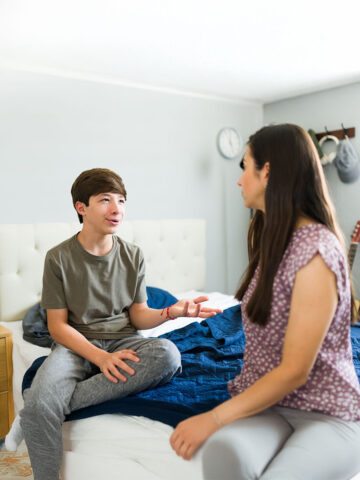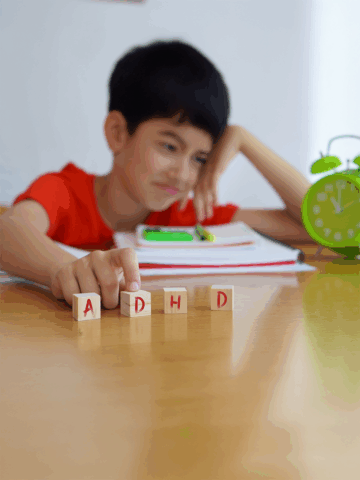Most kids have trouble sitting still, paying attention and waiting their turn at times, but if your child seems to frequently have severe trouble with staying focused, it may be a sign that they have attention deficit hyperactivity disorder (ADHD). Although there are many misconceptions about ADHD, it is a common neurological condition that causes impairment with focus, motivation and behavior regulation.
Scott Ryan, a licensed marriage and family therapist at the Intensive Outpatient Program (IOP) at CHOC, has worked for many years helping different schools, teachers and parents assess and treat ADHD in children. In this article, he debunks ADHD myths; discusses common signs and behaviors; addresses how ADHD may impact kids and teens throughout their lives; and offers strategies on how parents can help.
Myths of ADHD
Many families may start to wonder if their child has ADHD based on untrue statements coming from their child, teacher or friends, says Scott. Parents may hear phrases like the following about their child:
- “Your child is lazy! They have the ability; they just don’t try hard.”
- “If your child paid more attention, they could do the work.”
- “I told your child do something multiple times and they didn’t do a thing.”
- “I’m bored! Everything’s boring! I’m worried that I will be bored.” All kids say this, but ADHD kids experience boredom frequently.
- “They’re the bad kid because the teacher always tells them to sit down or pay more attention.”
But what these teachers or friends may not know is that ADHD is a neurological disorder, rather than a behavioral problem, deficit of discipline or just a “kid thing” that they will grow out of.
In fact, research has shown that 65 percent of kids with ADHD will have symptoms as adults. However, ADHD symptoms in adults may present themselves much more subtly because they have had years to learn how to manage them.
Although some people may think ADHD is over diagnosed, less than 60 percent of all children with ADHD are diagnosed or treated – a lot of kids do not get diagnosed, sometimes leading to worsening symptoms, more complications and reduced self-esteem. Early diagnosis and treatment improve child outcomes, increasing adaptive functioning and quality of life.
Some may think that treating ADHD with medication will make kids and teens drug dependent throughout their lives. But actually, says Scott, nonmedicated people with ADHD may be more likely to try substances because of having impulsive behavior. Medication reduces impulsive behaviors in people with ADHD, thus reducing their risk of substance use to typical levels.
Types of ADHD
To receive an ADHD diagnosis, a child or teen must exhibit at least six behaviors of the three subtypes of ADHD. Here are some practical examples of common ADHD behaviors — that can be seen from an outside perspective — associated with each type, says Scott.
Hyperactive/impulsive type
The following ADHD behaviors are reflective in young children, so it’s important to look for these symptoms to catch a diagnosis early. Qualitatively, some behaviors might look different from these descriptions, says Scott.
- They are always on the move, can rarely sit still and are fidgety.
- They are a chatterbox! They may talk excessively and will have great difficulty when needing to stop talking. In this case, hyperverbality is represented by hyperactivity.
- The child leaves their seat in the classroom or in other situations where remaining seated is expected.
- They run about or climb excessively in situations where it is inappropriate.
- They have difficulty playing or engaging in leisure activities quietly.
- They appear “on the go” or act as if “driven by a motor.”
- They blurt out the answers before the questions have been completed.
- They have difficulty awaiting their turn.
- They interrupt or intrude on others during conversations or games.
Inattentive type
The inattentive type of ADHD can be subtle or more profound. Again, a child or teen must exhibit at least six of these behaviors to qualify for an ADHD diagnosis.
- They fail to give close attention to details or make careless mistakes in schoolwork, work or other activities.
- They have difficulty sustaining attention in tasks or play activities.
- They do not seem to listen when spoken to directly.
- They do not follow through on instructions and fail to finish schoolwork, chores, or duties in the workplace. However, this is not attributed to oppositional defiant disorder (ODD) or failure to understand instructions.
- They appear to be daydreaming a lot, and they don’t respond quickly when prompted or may seem like they are ignoring you.
- They have difficulty organizing tasks and activities.
- They may avoid, dislike or be reluctant to engage in tasks that require sustained mental efforts, such as schoolwork or homework.
- They may lose things that are necessary for tasks or activities like toys, school assignments, pencils, books or tools.
- They are constantly forgetful and may forget instructions soon after being told.
- They may be easily distracted by extraneous stimuli.
- They may be forgetful in daily activities.
Combined type
The combined type is when a child is both hyperactive/impulsive and inattentive. This type of ADHD may have a larger impact on a child’s functioning and may be more challenging to manage. For a combined-type diagnosis, a child must have at least six symptoms from each sub type.
There are also a few other indicators of ADHD that may be seen from an outside perspective in a clinical or school setting.
Frequent or repeated trips to the emergency department due to injuries or broken bones when playing may be indicators that a child or teen is impulsive and risk seeking. They may be more willing to give dangerous activities a try.
At school, a child or teen may have disciplinary referrals for not following rules or directions; they may be impatient and cut in line; or they act a bit more immature and emotionally reactive. They may also get in trouble for hitting others or saying things that few other kids might say — they may not regulate emotions as well as other kids their age.
Less noticeable ADHD behaviors
Although many of the signs and behaviors of ADHD can be practically seen by parents, teachers and friends, some ADHD behaviors are more subtle and less noticeable. Scott says that most kids with ADHD may also have more internal behaviors like:
- Poor incidental learning – kids may have greater difficulty linking their behavior with consequences.
- Decreased sensitivity to rewards and punishments – it may take more repetitions for kids to make connections with outcomes.
- Poor executive functioning in the decision-making part of the brain — kids may not plan ahead for the future and may have a limited working memory and variable attentional focus. They may not be able to juggle multiple thoughts at once.
- Sleep disorders – it may be hard to get to sleep, and if they are the inattentive type, they may have difficulty waking.
- Impaired sense of time – time may go very slowly for a child with ADHD, much less than parents or even typical kids.
- Low frustration tolerance – they easily get impatient and may state, “I just want to quit.”
How to assess for ADHD
Research shows that 7 to 15 percent of kids may have ADHD. The easiest way to diagnose ADHD is through observations of signs and symptoms, says Scott, and parents, teachers, therapists or pediatricians may be able to recognize ADHD symptoms. Then, they can either inform their child’s school or pediatrician about their concerns and ask for an assessment.
Formal assessments, such as the Connors scale and Vanderbilt scale, may be used to gather information from multiple informants.
Confounding variables of ADHD
Although there are some clear signs and assessments that may point to ADHD in kids and teens, there are also times that ADHD may be more difficult to pinpoint like in girls, children with anxiety or depression, and intelligent children. Scott points out confounding variables that parents may need to consider when assessing their children for ADHD.
ADHD symptoms for girls
Girls with ADHD look different than boys, says Scott. Because some girls may feel more pressured to conform, they are more likely to internalize behaviors, not be as disruptive during class, and typically have more sophisticated social interactions — causing them to often be underdiagnosed. ADHD may affect girls’ social relationships more than boys, and they are more likely to suffer from lowered self-esteem, anxiety or depression.
In addition, girls may be more likely to have the inattentive type of ADHD — if they do have hyperactive ADHD, they may be hyperverbal rather than hyperbehavioral. They may talk a lot but be able to sit still.
Girls are also more likely to compensate for their ADHD by spending hours on homework. Even if they get good grades, they may feel like they are not smart because their homework took so long to finish.
Suppressed ADHD in the presence of depression and anxiety
Anxiety disorders and depression may hide ADHD symptoms and can get in the way of a diagnosis. Highly anxious kids may suppress their native hyperactivity to avoid attention but may show bursts of energy and increased frustration instead. When they truly get to know you, their impulsivity may show more clearly.
Like anxiety, depression may also suppress the intensity of ADHD symptoms. Because depressed kids or teens may be less engaged with others and not participate in as many activities, they don’t appear as hyperactive.
Intelligent kids can still have ADHD
Parents with intelligent kids may hear things like, “Your kid doesn’t have ADHD because look how smart they are!”
Especially smart kids are less diagnosed with ADHD, but they are still impacted by having to overcompensate to get their good grades.
Other confounding variables of receiving an ADHD diagnosis
In addition to the ways that social pressures, anxiety, depression and intelligence might hinder a prompt ADHD diagnosis, there are some additional reasons that kids may less likely to get diagnoses with ADHD.
Because ADHD may run in families, some kids may go undiagnosed if one or both of their parents also have undiagnosed ADHD. If a parent has undiagnosed ADHD, they may be less likely to notice ADHD behaviors in their children; ADHD behaviors may be considered normal for their family; or they may not be able to point out hyperactivity or inattentiveness in their children if they are hyperactive or inattentive.
Teachers may not always be able to notice ADHD symptoms in kids because they aren’t familiar with the symptoms or are too busy with teaching to observe a child. It’s also possible that a teacher may have undiagnosed ADHD, says Scott.
There are some common fears, much like the ADHD myths that were mentioned earlier, that may lead to avoidance of addressing ADHD in kids or teens. Parents may not want their child to be affected by the stigma of a diagnosis; they may not want their kids to be on medication; or they may think that if they ignore the problem, it may just go away.
ADHD’s impact on a child’s functioning
ADHD can affect multiple aspects of a child or teen’s life. Kids and teens with ADHD are at a greater chance to develop other mental health disorders like oppositional defiant disorder, learning disabilities, depression and anxiety. ADHD may also impact them in the following ways, says Scott:
- They may be labeled by peers or staff in the classroom.
- They may have inconsistent work performance.
- They may lack social skills, which can have an especially high impact on girls with ADHD.
- They may avoid work that requires sustained attention — homework may take hours.
- They may have decreased self-motivation and persistence.
- They may not respond as well to rewards or consequences.
Although ADHD symptoms tend to lessen over the course of a lifetime, they are likely to persist through adulthood, impacting multiple aspects of life like:
- Increased chance of job loss — they may be 61 percent more likely to be terminated and 53 percent more likely to quit a job due to disliking it.
- Increased divorce rate — they might be up to twice as likely to divorce than adults without ADHD.
- They may have an increased chance of substance abuse.
- They may receive more speeding tickets.
What can parents do to help their kids with ADHD?
Because ADHD can impact children and teens for their entire lifetime, the best way that parents can help their kids is to know the signs and symptoms of ADHD to get their child assessed earlier rather than later.
If your child is diagnosed with ADHD, seeking treatment options can help reduce the impact of the disorder, Scott says.
Treatment for ADHD
Behavioral therapy, medication or a combination of the two may be effective ways to treat ADHD. Often, says Scott, families want to try behavioral treatment first, especially with mild-moderate symptoms. If a child or teen has mild to moderate symptoms of ADHD, behavioral therapy may be a sufficient treatment entirely.
For kids and teens with more severe ADHD symptoms, medication is very effective – it makes an ADHD brain function like a neurotypical brain.
Increased structure and routines for ADHD
Increased structure and daily routines can be very helpful for both the hyperactive and inattentive types of ADHD in kids.
For kids with hyperactivity, structure and routines can establish limits and prioritize important tasks with fun activities. For kids with inattentiveness, a structure and routine may help them by dedicating specific times for defined purposes. Following a pattern may also reduce forgetfulness in inattentive kids.
To improve homework completion, Scott suggests creating a daily, sequential routine, such as having your kids set their backpacks in the same place every day when they get home from school, showing you any homework they brought home and having a snack or watching TV for 30 minutes before you both do homework together.
Rewards for children with ADHD
For kids with ADHD, rewards are more effective than punishments or consequences. However, the rewards often need to be larger and more frequent to get the same effect as they would with neurotypical kids.
Since ADHD kids struggle with incidental learning, or the ability to link behaviors with consequences, it is harder for them to link events with outcomes. It may take many repetitions for them to learn the rule. Hyperactive kids might be less motivated to follow the rules, as it takes a lot of effort to overcome impulsiveness, and inattentive kids might repeatedly forget the rules. They may need more reminders.
Scott says it’s also helpful to set up a rewards schedule by doing the following:
- Choose no more than two primary behaviors for your kids to focus on for a certain period of time.
- Figure out how often they do the thing you want without rewards.
- Set a realistic goal that they are likely to succeed in that first week, so they can link the rewards with their performance.
- Figure out what motivates them – what rewards would they want?
- Make sure to give them the reward!
- Don’t take the reward away as a consequence. Choose a different consequence instead.
- If the rewards worked, keep going and extend the goals.
If this rewards process didn’t work, Scott says, it’s possible that the rewards were not big enough or they weren’t what your child would want. They may need more immediate feedback – perhaps a smaller reward in the meantime, leading to a bigger reward.
The power of praise for kids with ADHD
The power of praise benefits kids in so many ways, says Scott. Since children naturally seek out and desire acknowledgment for their actions, a child who is regularly praised will be receptive to requests to change their behavior.
And, providing more frequent praise will increase the connection between your child’s behavior and receiving praise. Parents should ideally give praise immediately after their child’s desired behavior, and it should be specific to that behavior. Many studies show that a ratio of five to one, five praises to one change statement, is ideal, but even a three-to-one ratio is likely to improve behavior.
Keep instructions short and sweet for kids with ADHD
Since your child with ADHD likely has a very short interest span if they are hyperactive, a very short attention span if they are inattentive and poor working memory, you should always keep directions very brief and specific.
Scott says that directions should be 10 words or less, like: “Do this. Don’t do that. Go play.”
In summary, Scott hopes that parents of kids with ADHD can help them by doing the following:
- Stick to schedules.
- Promote routines to reduce forgotten steps and improve consistency.
- Provide frequent breaks by breaking up activities into smaller chunks.
- Provide frequent rewards.
- Pick your battles! Ignore behaviors that are not interfering with daily functioning. Remind yourself that your child is doing the best that they can, even if you wish they would do better.
For more information about ADHD, hear about diagnosing ADHD and how to manage ADHD and watch videos from CHOC experts.
Watch Scott’s full webinar on this topic as part of CHOC’s Mental Health Education Program (MHEP), which offers free webinars to parents on a variety of subjects. To view upcoming webinars, view the MHEP events calendar.





